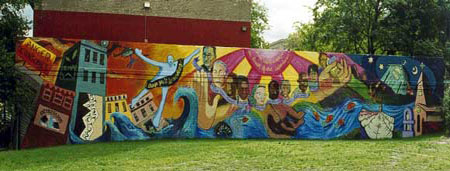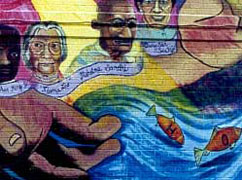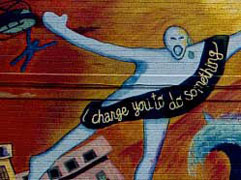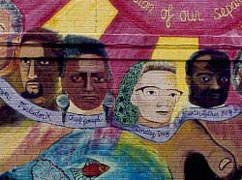

[2001-1996 Projects]
* Sunset Park Unity Mural
* Groundswell Summer...
* Scene Through a Fence
* Peace is Not A Dream...
* We are Here to...
* Paradise Lost and...
* Everyone Holds a World...
* How Our People Left...
We Are Here to Awaken From the Illusion of Our Separateness

WE ARE HERE TO AWAKEN FROM THE ILLUSTION OF OUR SEPARATENESS
Groundswell Community Mural Project ©
www.groundswellmural.org
Acrylic on Wall
16 x 86 Ft
1998
Artists: Amy Sananman, Directors Joe Matunis & Jenny Laden, Volunteers
Location: E174th Street & Stratford Ave, Bronx, NY
Community Partner: Youth Ministries for Peace and Justice
During the summer of 1998, fifteen young people worked with Groundswell to create a mural around the theme of spiritual leaders for peace and justice. The team represented youth (ages 12 – 22) of Muslim, Pentacostal, Catholic, Buddhist, Hindu, Native American and Jewish faiths. They came from as nearby as the Soundview/Morrison neighborhood of the Bronx (where the mural is located) and as far as from Harlem, Brooklyn and Queens. This diverse and unique group spent the summer visiting numerous places of worship and researching concepts of, and leaders, in peace and justice across their denominations.
The group found commonalities among religions and what leaders fought for and commonalities between each other along with an understanding of the social dimension to spiritual convictions. Perhaps the most critical messages are best expressed in the title of the work (which is a quotation from Vietnamese Buddhist monk, Thich Naht Hahn) and the charge to action that "awakening" compels in us.
The group wanted to portray not only the spiritual leaders of peace and justice movements, but the things they fought against and how they fought. On the right of the mural, we see a city overwhelmed by tumultuous waters and lit by a fiery sky. The city's billboards "advertise" anger, racial injustice and envy-examples of what spiritual leaders fought against, as well as in many cases, causes for their assassination or imprisonment. We see an army-colored helicopter dropping faceless figures into the water. The group took this image from a story told about the dictatorial Argentinean regime drugging opponents of the government and dropping them into the river. The facelessness comes from a Native American practice of creating faceless dolls for children so they remain humble. The combination shows that we can all be and therefore should all relate to victims of injustice. One of the victims wears a banner quoting Rabbi Marshall Meyer, "I charge you to do something."
As the waters move toward the center of the mural, we see a Native American "dream catcher" which traditionally is placed above the bed to filter out evil and let through good. In the center of the mural, the group decided to create a ring of spiritual leaders from different religions with light shed on them (listed below). The group wanted to convey the leaders as people, not as "gods." Portrayed as ordinary human beings, they serve as inspiration as well as conveying humility. The three large hands coming from the group symbolizes the three major approaches that religions take toward peace and justice. The leftmost hand is held up against the "evils" of the cityscape and represents political activism or standing up against injustice. The central hand is extended and symbolizes service to those in need. The rightmost hand represents meditation, prayer and inner peace as a means toward peace and justice. To the right, are images of religious spaces both real and imagined. These include buildings such as churches and mosques as well as nature. Finally, we see three young people on the grass apparently listening to the spiritual leaders and learning from their lessons. These figures represent the team and their acceptance of the responsibility to carry on the struggle for peace and justice themselves.
Spiritual leaders shown are (from left to right): Archbishop Romero, a Catholic leader for human rights in El Salvador; Rabbi Marshall Meyer, a Jewish leader for rights of the "disappeared" in Argentina; El Hajj Malik El-Shabbaz (Malcolm X), a Muslim leader who spoke out for rights of the oppressed; Chief Joseph, a Native American leader of the Nez-Pierce tribe who fought peacefully for the dignity and rights of his people; Dr. Martin Luther King, Jr., a Presbyterian Minister who fought for civil rights in the United States; Dorothy Day, a Catholic leader who founded the Catholic Worker and was one of the first to actively implement Catholic service organizations for the very poor in New York City; Leoncia Russeou ("Mama Leo"), a Pentecostal leader and one of the first to address the needs of chemically addicted people in New York; Mahatma Gandhi, a Hindu and leader in the non-violent struggle for rights in India; Aung San Suu Kyi, a Buddhist woman who has been under house arrest in Burma since 1989, where she continues to fight for democracy; and the Dalai Lama, the spiritual leader for Tibetan-Buddhists, currently living in exile fighting for the rights for religious freedom for Tibetans. The title quote is from Thich Nhat Hahn, a Vietnamese Buddhist monk and winner of a Nobel Peace Prize.
 |
 |
 |
